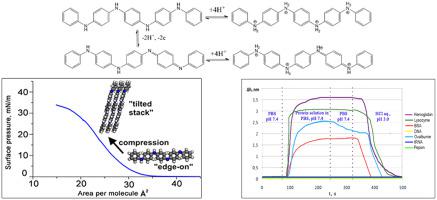Synthetic Metals ( IF 4.0 ) Pub Date : 2021-01-24 , DOI: 10.1016/j.synthmet.2021.116712 Elena Yagudaeva , Alexander Vikhrov , Yulia Malakhova , Yulia Iskandyarova , Maria Firsova , Anna Prostyakova , Alexei Korovin , Sergey Malakhov , Artemiy Nichugovskiy , Vitaly Zubov , Dmitry Kapustin

|
Polyaniline (PANI) is a polyconjugated polymer that attracts the attention of scientists for many years because of the possibility of its use in both organic electronics and as material for biomedical and electrophysical application, thanks to its high conductivity, chemical stability, the ability of redox and non-oxidative doping, biocompatibility and selective affinity for different types of biopolymers. However, volatility of physical and chemical properties of PANI limits its wide practical application as a component of composites. Those drawbacks could be overcome by the use of aniline oligomers that demonstrate reliable control and adjustment of their structure, better solubility and processability. In this research, we examined physical and chemical properties of phenyl end-capped tetraaniline (TANI) and its films, which are the lowest molecular weight derivatives of aniline in comparison with PANI. Self-organized thin film structures of TANI with well-defined morphology were prepared via transfer of Langmuir films obtained on the water-air interface. The behavior of TANI as bioseparating material as studied with spectral correlation technique on the examples of separation of nucleic acids and proteins was shown to be similar to PANI’s behavior. In particular, TANI demonstrates sorption inertness towards double strained nucleic acids and binds the proteins depending on their isoelectric points and hydrophobicity (“negative selection”).
中文翻译:

苯胺四聚体作为聚苯胺的结构类似物–生物医学应用有望的材料
聚苯胺(PANI)是一种聚共轭聚合物,由于其具有高电导率,化学稳定性和氧化还原能力,因此有可能同时用于有机电子产品以及用作生物医学和电物理应用的材料,因此吸引了科学家的关注。以及对不同类型生物聚合物的非氧化掺杂,生物相容性和选择性亲和力。然而,PANI的物理和化学性质的挥发性限制了其作为复合材料组分的广泛实际应用。这些缺点可以通过使用显示出可靠控制和调节其结构,更好的溶解度和可加工性的苯胺低聚物来克服。在这项研究中,我们研究了苯基端基四苯胺(TANI)及其薄膜的物理和化学性质,与PANI相比,它们是苯胺的最低分子量衍生物。通过转移在水-空气界面上获得的Langmuir薄膜,制备出具有良好形态的TANI自组织薄膜结构。通过光谱相关技术对核酸和蛋白质分离的实例进行研究,表明TANI作为生物分离材料的行为与PANI的行为相似。尤其是,TANI表现出对双倍应变核酸的吸附惰性,并根据其等电点和疏水性(“负选择”)结合蛋白质。通过光谱相关技术对核酸和蛋白质分离的实例进行研究,表明TANI作为生物分离材料的行为与PANI的行为相似。尤其是,TANI表现出对双倍应变核酸的吸附惰性,并根据其等电点和疏水性(“负选择”)结合蛋白质。通过光谱相关技术对核酸和蛋白质分离的实例进行研究,表明TANI作为生物分离材料的行为与PANI的行为相似。尤其是,TANI表现出对双倍应变核酸的吸附惰性,并根据其等电点和疏水性(“负选择”)结合蛋白质。











































 京公网安备 11010802027423号
京公网安备 11010802027423号